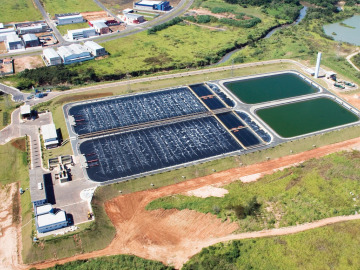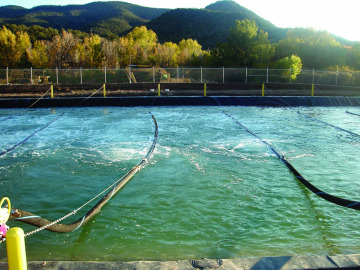Biolac Extended Aeration Treatment System - Columbiana, AL
The Customer
The City of Columbiana is located 25 miles southeast of Birmingham, AL in Shelby County and is home to approximately 4,200 residents. In 1988 the city installed a Parkson Biolac-R activated sludge process with integral clarifier having the following design parameters:
| Influent | Effluent | |
|---|---|---|
| Design Flow Rate | 0.75 MGD | |
| BOD (5) | 200 mg/l | 15 mg/l |
| TSS | 200 mg/l | 15 mg/l |
| NH3 | 25 mg/l | 3 mg/l |
During the early years of operation, the Biolac was simple to operate and worked well for the city. As the system aged the city started having issues with the aeration chain float design. This float design had a galvanized pipe running through it that would become rusty and eventually spring leaks forcing the city to frequently order new floats. According to Dale Lucas (plant manager) “This was a battle we could never win."
The Challenge
The city was tying to eliminate maintenance costs and performance issues associated with leaks coming from their older generation float design and diffuser membranes. According to Mr. Lucas “The dissolved oxygen (DO) in my plant was always changing and it was about to put my plant in violation on on my effluent DO. I knew I had to do something.”
The Journey
The city investigated different alternatives to resolve their problems. The city decided to use a bid process in order to obtain pricing for each alternative method. In the end, Columbiana found the the Parkson Biolac Rebuild and Retrofit program to be the most economical and ecological solution to the challenges they were facing.
The Solution
As part of the the Biolac rebuild and retrofit project at this plant, Parkson replaced all the in-basin aeration components. The older float and hose aeration chains were replaced with the new BioFlex floating HDPE pipe which has a longer life and better articulation. The previous Wyss Flex-a-Tube Diffusers were replaced with new BioFuser® assemblies. Not only are these BioFuser assemblies easier to install and operate at higher efficiencies, but they are also expandable. Each Biofuser assembly can support up to 5 diffuser tubes. At the Columbiana plant, each new Biofuser only has 2 tubes, and thus they have 150% aeration expansion capacity for the future.
In addition to providing all new hardware, Parkson engineers completed an in-depth review of the existing air diffusers and proposed a new layout that would dramatically improve air distribution and mixing in the basin.
The new equipment and process changes ensure that this refurbished Biolac® operates, and carries the same warranty, as a brand new unit.
This exclusive service provides a one-year warranty for the Biolac® system with an on-site certified rebuild or supervised on-site rebuild. When the rebuild or retrofit is completed, a Parkson-certified specialist will provide an operational refresher course to ensure smooth startup of the equipment.
The Implementation
A certified Parkson Biolac field technician was on site to supervise the plant personnel with installation of the Biolac equipment. Drawing upon Parkson experience from 800 installations over a 25+ year experience, this technician was able to instruct on the simplest and most efficient way to install the equipment. According to Mr. Lucas “We were pleased with the knowledge of the Parkson field technician and couldn’t have done this without his expertise”. There was no downtime or disruption to the system during the rebuild. The only issue during the rebuild was the amount of torque required on the nuts which holds the new diffuser together. Parkson was quick to respond to the correct torque requirements. From start to finish the project took 10 working days.
Once the installation was complete, a Parkson Biolac System process expert visited the plant to review the new operation and provided answers to any questions from plant personnel.
The Results
The plant has seen significant improvement in performance as a result of the rebuild. Plant D.O. levels have increased over 700%, from 0.43 D.O. with their old equiopment up to 3.33 D.O. with their new equipment. This has reduced ammonia concentrations of the effluent to non-detectable levels. At the same time, energy consumption has decreased by 40% resulting in a $900/month cost saving and the need to only run one blower at night as opposed to two prior to the rebuild. The reduction in blower usage will provide further savings in the future in the form of reduced maintenance costs.







